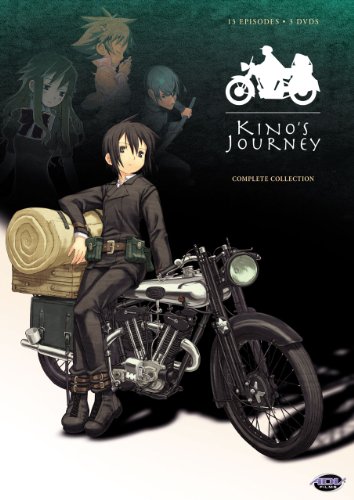All Nonfiction
- Bullying
- Books
- Academic
- Author Interviews
- Celebrity interviews
- College Articles
- College Essays
- Educator of the Year
- Heroes
- Interviews
- Memoir
- Personal Experience
- Sports
- Travel & Culture
All Opinions
- Bullying
- Current Events / Politics
- Discrimination
- Drugs / Alcohol / Smoking
- Entertainment / Celebrities
- Environment
- Love / Relationships
- Movies / Music / TV
- Pop Culture / Trends
- School / College
- Social Issues / Civics
- Spirituality / Religion
- Sports / Hobbies
All Hot Topics
- Bullying
- Community Service
- Environment
- Health
- Letters to the Editor
- Pride & Prejudice
- What Matters
- Back
Summer Guide
- Program Links
- Program Reviews
- Back
College Guide
- College Links
- College Reviews
- College Essays
- College Articles
- Back
Kino's Journey
What would you do?
This is a question that Kino’s Journey asks many times over. Kino’s Journey is an anime series based off of a series of light novels by the same name, written by Keiichi Sigsawa. It is made up of thirteen episodes (including an OVA) and two 30-minute films. Kino’s Journey receives very little glory in the anime universe. Whether this may be due to its shortage of episodes, its unique animation style, or its disjointed storylines, Kino’s Journey does have its merits.
Kino is a teenage girl who abandoned her homeland at age twelve to travel the world with a talking motorcycle named Hermes (trust me, it’s not near as goofy as it sounds). Kino moves from country to country, meeting different people and facing different situations, but she only ever stays in any country for three days, always leaving for the next on the third. The series is based around her experiences at numerous different countries. The episodes are not connected, save one story that spans over two episodes, and presumably takes place at different points in time, but in the same world. The series delves into several relatable motifs, such as passion and justice, and also has a noticeable emphasis on futility. Each episode asks thoughtful questions: Is it moral to pursue dreams on the expense of others? Do people have a right to stand against another’s tradition if they believe it to be immoral? If deliberately causing chaos in one place creates peace in two others, is it acceptable to do so? Can one creature’s life be valued over another’s? If people know that something is pointless, why do they continue on? These questions are not clearly answered, but rather, left for the viewer to mull over. Kino’s Journey is the type of show to leave someone staring, gaping at a black screen, wondering why things happened the way they did, and what it means.
Kino herself is quite an interesting character. She’s a tomboy, and often mistaken for a boy, but doesn’t mind. At any given time, she always carries two guns with her, one which she calls “Cannon” and the other “Woodsman”. She’s quiet, and generally very passive, which gives us a chance to question the morality of what goes on around her, and her own morality for reacting the way she does. She can be difficult to understand, but she’s also fun to observe—every step she takes is a chance for us to get to know her better. Hermes, on the other hand, seems to appear out of necessity—if Kino hadn’t had anyone to talk to, we’d never learn anything about her, and Hermes’ existence helps lighten the heavy atmosphere created by a fairly dark series. Kino’s interactions with Hermes help create the comedic relief we see throughout the anime.
Kino’s Journey is not the best choice for someone who prefers a continuous story, but its format makes it easy to watch an episode every so often, or skip around, without getting lost. I also find it to be a great anime for anyone who is looking for inspiration, since its scenarios, both unique and outwardly realistic, offer up plenty of questions to be answered and ideas to be voiced. Kino’s Journey may not be very popular, but if you are the kind of person who enjoys shows that leave you thinking, this is a good place to start.
Similar Articles
JOIN THE DISCUSSION
This article has 0 comments.

